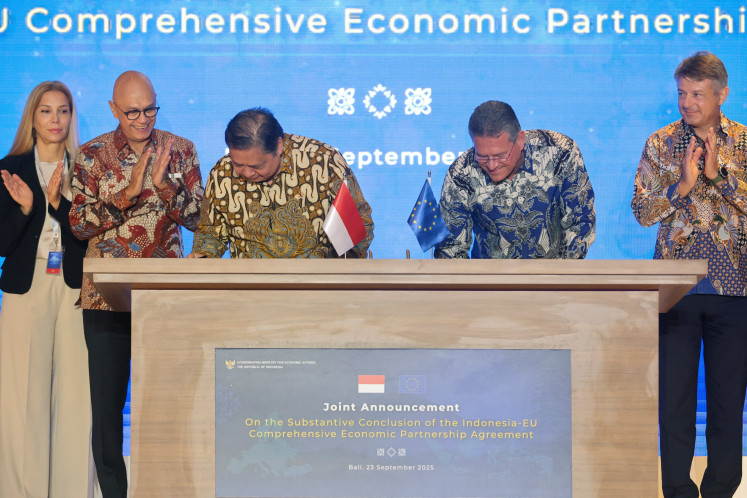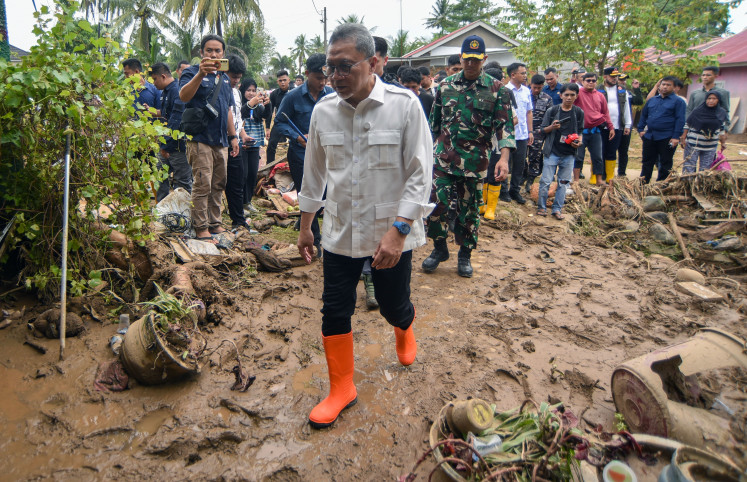Popular Reads
Top Results
Can't find what you're looking for?
View all search resultsPopular Reads
Top Results
Can't find what you're looking for?
View all search resultsRigid bureaucracy hampers new ministers
JP/Seto WardhanaThree days after the presidential inauguration, Joko “Jokowi” Widodo announced the 38 Cabinet members who will serve during his second term
Change text size
Gift Premium Articles
to Anyone
JP/Seto Wardhana
Three days after the presidential inauguration, Joko “Jokowi” Widodo announced the 38 Cabinet members who will serve during his second term. Twelve deputy ministers were also introduced as part of the Indonesia Onward Cabinet. Jokowi emphasized that he expected results and that those who failed to deliver would be shown the door.
To get things done, a minister needs to be agile. However, political accountability and bureaucratic rigidity limit ministers’ much-needed managerial flexibility.
To see how political accountability plays out, consider planning and budgeting, both of which are parts of core government activities conducted ahead of the new fiscal year. The programs and budget of 2020, for example, were formulated earlier this year.
The deliberation process is long and involves many stakeholders. A ministry needs to coordinate with the National Development Planning Agency (Bappenas) and the Finance Ministry. Then, the House of Representatives must approve the proposed programs.
While the system is meant to ensure sufficient checks and balances, it restricts ministers’ capacity to unilaterally adjust the sails if the wind shifts during implementation.
For now, at least, this has been taken care of. Jokowi has secured the support of a majority in the House, and ministers can rest assured that opposition will be minimal. Greater focus should, therefore, be directed toward internal rather than external consolidation.
Addressing bureaucratic rigidity could be equally, if not more, challenging. There are at least two constraints in this regard.
First is the budget constraint. Ministries’ funds are limited; allocating more money for one program means taking it away from another. Given this necessary trade-off, it is common to break programs into smaller, manageable multiyear projects.
Can the government increase the budget to speed up progress? Yes — by increasing revenues conventionally (i.e. tax collection) or by tapping into additional sources of credit. Either way, a minister cannot do it alone and has to get a green light from the finance minister.
For some ministers from the private sector, government budget practices may come as a surprise. Alternative financing schemes, such as asset monetization or venture capital funding, are often legally impractical in the public sector, even if they are financially feasible.
In case the budget was enough, another challenge persists. Incrementalism remains the dominant approach in government planning and budgeting. Ministerial programs are seen mostly as recurring activities, and budget allocation is based on last year’s spending plus an adjustment for inflation. This approach, albeit sometimes practical, can be problematic if programs were not carefully designed in the first place.
A possible remedy to incrementalism is a performance-oriented budgeting approach. This method sets a long-term policy objective as an end goal and works backward to shorter-term outcomes to establish the budget allocation.
Not only does this approach ensure money is spent to achieve tangible results, it is also aligned with Jokowi’s message to his ministers: There is no such thing as the vision of a minister, only the vision of the President and Vice President. Jokowi’s mandate is a long-term policy objective, and the task of ministers is to come up with relevant short-term outcomes through programs and their allotted budget.
The second constraint is finding an appropriate mix of inputs. Think about all possible inputs in a government program and put them into two categories: capital and labor.
Procuring physical capital like infrastructure and office facilities is achievable when a competitive market exists. Regulation allows ministries to proceed with the cheapest offer that meets a certain quality standard.
But recruiting labor is much harder. For a visionary minister, innovation and impact starts with a strong team. Unfortunately, given the prevailing bureaucratic rigidity, establishing one can be difficult. The minister can neither fire nonperforming staff, nor hire great talent directly to the civil service. All recruitment needs to go through a centralized system organized by the Administrative and Bureaucratic Reform Ministry. This usually takes months. As a result, there is often a mismatch between the supply of and demand for labor across ministries.
One quick fix is to create an ad-hoc team of professionals that reports directly to the minister. They are hired on a nonpermanent basis to pursue a specific mission. Some of Jokowi’s first-term ministers did this.
Former maritime affairs and fisheries minister Susi Pudjiastuti formed a task force to help her fight illegal, unreported and unregulated fishing. Former energy and mineral resources minister Sudirman Said also used a reform team to root out unscrupulous practices in the oil and gas sector.
But this method is only a short-term solution, as impacts tend to be limited and unsustainable. To bring about an agile government, the whole human resources management process (recruitment, rewards and punishments, etc.) must be transformed. We must let ministers manage.
Jokowi wants government programs delivered, and his ministers stand ready to assist him. However, bureaucratic rigidity will hamper effective planning, budgeting and policy implementation. A minister is expected to be persistent and is authorized to manage internally, but a bigger, lasting change will require the President to reform Indonesia’s whole state bureaucracy and public administration system.










